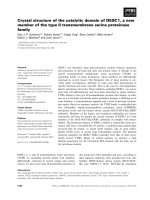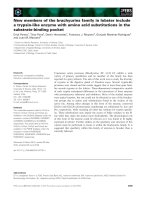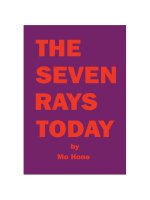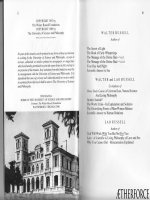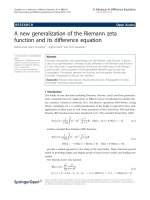New record of the monocled cobra Naja kaouthia Lesson, 1831 (Squamata: Elapidae) from Son La province, Northern Vietnam
Bạn đang xem bản rút gọn của tài liệu. Xem và tải ngay bản đầy đủ của tài liệu tại đây (289.25 KB, 4 trang )
Management of Forest Resources and Environment
NEW RECORD OF THE MONOCLED COBRA Naja kaouthia Lesson, 1831
(SQUAMATA: ELAPIDAE) FROM SON LA PROVINCE,
NORTHERN VIETNAM
Dinh Sy Tuong1, Pham Trung Hieu1, Dinh Thi Thuy Dung2, Luu Quang Vinh1*
1
Vietnam National University of Forestry
Hong Duc University
2
SUMMARY
In Vietnam, the Monocled cobra Naja kaouthia is a poorly known species with few records from Quang Tri,
Thua Thien-Hue, Lam Dong, Dong Nai, Ho Chi Minh City, Dak Lak and Kien Giang provinces. The species is
diagnosed in morphology as follows: Large head; a cuneated scale between fourth and fifth infralabial; single
preocular; postoculars 2 - 3; supralabials 7/7, the third & fourth entering orbit; 4 infralabials contact anterior chin
shields; rounded hood with O-shaped marking. Body robust, cylindrical; scales smooth, mid-body scale rows 19
- 21 (usually 21); ventrals 164 - 197. Tail short, tapering; paired subcaudals 43 - 61. During recent herpetological
survey in the karst forest of Van Ho District, Son La Province, Vietnam, a female specimen of the genus Naja
was collected at an elevation of 800 m a.s.l. in a mixed habitat of the secondary karst forest and agricultural area.
Based on morphological examination, our specimen is totally agreed with the Monocled cobra Naja kaouthia
Lesson, 1831 description of Smith (1943), Das (2010), Chan-ard et al. (2015) and Vassilieva et al. (2016). Thus,
the species is recorded for the first time from Son La Province. The species is listed in the Appendix II of CITES
(2019) and Group IIB of the Vietnamese Governmental Decree No 06/2019/ND-CP.
Keywords: Morphology, Naja kaouthia, new record, Son La province.
1. INTRODUCTION
Monocled cobra Naja kaouthia Lesson, 1831
was originally described based on the holotype
collected from Bengal, India. The species is
diagnosed based on the following characters
from Smith (1943), Das (2010), Chan-ard et al.
(2015) and Vassilieva et al. (2016): total length
1500 - 2300 mm; body robust; head large,
distinct from neck; frontal short, squarish; a
cuneate usually present; single preocular;
postoculars 2 - 3; supralabials 7/7; supralabials
III-IV contact orbit; 4 infralabials contact
anterior chin shields; hood rounded; eye
moderate; pupil rounded; tail short; dorsals
smooth, glossy; 25 - 31 scales on the neck, 19 21 scales on midbody (usually 21, rarely 23), 17
or 15 scales in front of the vent; ventrals 164197; subcaudals 43 - 61, paired. Coloration:
Dorsal surface brown, greyish-brown, blackishbrown or pale yellow; some with darker bands;
hood marking typically a light circle, or maskshaped with a dark centre; 1 - 2 dark spots
sometimes present in pale oval portion; light
throat colour with paired lateral spots; rest of
ventral surface similar to dorsal surface or with
dark pigmentation towards tail; subcaudals darkedged. The species is known to occur from India,
*Correspondence authors:
114
Nepal, Bangladesh, China, Myanmar, Laos,
Thailand, Cambodia, Vietnam to Malaysia
(Das, 2010; Chan-ard et al., 2015; Vassilieva et
al., 2016). However, it is a poorly known
species in Vietnam with few records from
Quang Tri, Thua Thien-Hue, Dak Lak, Lam
Dong, Dong Nai, Ho Chi Minh City and Kien
Giang provinces (Nguyen et al., 2009;
Vassilieva et al., 2016).
During a recent herpetological survey, an
adult female of the genus Naja was found on a
milpa near Hua Tat village, Van Ho commune,
Van Ho district, Son La province. Based on
morphological examination of this specimen,
we herein report the first record of Naja
kaouthia from Son La province.
2. RESEACH METHODOLOGY
Sampling
A field survey was conducted in the karst
forest of Van Ho commune, Van Ho district, Son
La province by Pham Trung Hieu and Tranh A
Phanh in May 2021. The specimen was
anaesthetized with ethyl acetate, fixed in
approximately 85% ethanol, and then transferred
to 70% ethanol for permanent storage (Simmons,
2002). The specimen was subsequently deposited
in the collection of the Vietnam National
University of Forestry (VNUF), Hanoi, Vietnam.
JOURNAL OF FORESTRY SCIENCE AND TECHNOLOGY NO. 11 (2021)
Management of Forest Resources and Environment
Morphological characters
Identification of sex was performed by
inspection of presence of hemipenes.
Measurements (in mm) were taken in the
preservative specimen with a measuring tape.
Scale counts were taken following Luu et al.
(2018). The number of ventral scales was
counted according to Dowling (1951). The
numbers of dorsal scale rows (DSR) are given
at one head length behind head, at midbody, and
at one head length before vent, respectively.
Scalation was studied by using a binocular.
Bilateral values were given as left/right.
Measurements were abbreviated as snout-vent
length (SVL) and tail length (TaL). For
identification, we referred to the data provided
by Smith (1943), Das (2010), Chan-ard et al.
(2015) and Vassilieva et al. (2016).
3. RESULTS
Naja kaouthia Lesson, 1831
Monocled cobra/ Rắn hổ mang một mắt kính
(Fig. 1)
Specimen examined (n = 1). One adult
female, VNUF R.2021.1 (field number VH.01)
was collected on 30th May 2021 by Pham Trung
Hieu and Trang A Phanh on a milpa
(20046'330''N/1040 46'230''E, at an elevation of
800 m a.s.l.) of Hua Tat village, Van Ho
commune, Van Ho district, Son La province,
Vietnam.
Morphological characters. The specimen
from Son La agreed well with the descriptions
of Smith (1943), Das (2010), Chan-ard et al.
(2015), Vassilieva et al. (2016): SVL 1275 mm,
TaL 24 mm; body robust; head large, distinct
from neck, with blunt sloping snout; eye large,
with a round pupil; loreal absent; internasal
shorter than prefrontal; preocular 1/1;
postoculars 2/2; anterior temporals 2/2,
posterior temporals 2/3; supralabials 7/7, third
to fourth entering orbit; infralabials 8/8, first to
fourth bordering anterior chin shields, a cuneate
present between the fourth and fifth of
infralabials (both side); dorsal scale rows 27-2115, smooth and glossy; ventrals 196; cloacal
undivided; subcaudals 4 (tail lost), divided.
Figure 1. (A) Dorsal view; (B) Ventral view; (C) Lateral dead view, a small cuneate present between
the fourth and fifth of infralabials; (D) Hook O – shaped.
(Photos: Luu Quang Vinh)
JOURNAL OF FORESTRY SCIENCE AND TECHNOLOGY NO. 11 (2021)
115
Management of Forest Resources and Environment
Coloration in preservative. Dorsum blackishbrown; a large snake with a hood with a single
O-shaped; 2 black spots on the lower surface of
the hood on both side; a black cross-bar (about
6 ventral scales wide) on the belly behind it;
light throat colour, white cream from chin to the
neck, rest of ventral with dark pigmentation
towards tail; subcaudals dark-edged.
Distribution. In Vietnam, this species is
known to occur in Central and southern
Vietnam including: Quang Tri, Thue Thien-Hue
(Thua Luu), Dak Lak (Chu Yang Sin), Lam
Dong (Da Lat), Dong Nai, Ho Chi Minh City,
Kien Giang (U Minh Thuong) (Nguyen et al.,
2009; Vassilieva et al., 2016). This is the first
recorded of the species in Son La province.
Elsewhere, this species recorded from
Northeastern India, Nepal, Bangladesh,
Myanmar, Laos, Thailand, Cambodia, southern
China and northern West Malaysia (Nguyen et
al., 2009; Vassilieva et al., 2016).
Figure 2. Map showing the new distribution record of Naja kaouthia (red circle)
in Son La province, Northern Vietnam
Ecological notes. The individual was
collected at 14:19 on the ground while crawling,
at an elevation of about 800 m a.s.l. The
surrounding habitat was milpa, near the karst
forest.
4. DISCUSSION
Interviews with local people indicated that
the species has been recognized to occur in the
recorded site for a long time. Local people have
sighted and collected the species for food and
traditional medicine. Captive farms of snakes is
unknown so far in the village. Thus, it seems to
represent an overlooked population of the
species in this province. In addition, the
116
recorded site is only 70 km away from the
Vietnam-Laos border where the species is
naturally distributed. Therefore, morphological
and genetic variations of the species across its
distribution range should be investigated. In
terms of conservation concern, Naja kaouthia
was listed in the Appendix II of the CITES
(2019) and in the Group IIB of the Vietnamese
Governmental Decree No 06/2019/ND-CP on
the management of endangered wild flora and
fauna.
5. CONCLUSION
We report the Monocled cobra Naja
kaouthia for the first time from Son La province
JOURNAL OF FORESTRY SCIENCE AND TECHNOLOGY NO. 11 (2021)
Management of Forest Resources and Environment
based on morphological characters of one
female specimen collected in Van Ho district,
Son La province, Northern Vietnam. The
species is listed in the CITES (2019) and the
Vietnamese
Governmental
Decree
No
06/2019/ND-CP on the management. Further
research on distribution, population status and
threats to the species is needed to provide
baseline data for conservation measures.
Acknowledgements
Pham Trung Hieu thanks Trang A Phanh,
local authorities and local people of the Van Ho
commune for supporting his fieldwork. We
thank E. Sterling (New York) and K. Koy
(Berkeley) for providing the map.
REFERENCES
1. Chan-ard, T., Parr, J. W. K., Nabhitabhata, J.
(2015). A field guide to the reptiles of Thailand. Oxford
University Press USA, 314 pages.
2. Checklist
of
CITES
Species
(2019).
. Downloaded on 10th October 2019
3. Das, I. (2010), A field guide to the reptiles of
South-east Asia. London: New Holland Publishers (UK),
Ltd.; p. 376.
4. Dowling, H.G. (1951). A proposed standard
system of counting ventral in snakes. Journal of
Herpetology 1: 97-99.
5. Government of the Socialist Republic of Vietnam
(2019), Decree 06/2019/ND-CP on management of
endangered, precious and rare species of forest fauna and
flora
6. Luu, Q.V., Bonkowski, M., Nguyen, T. Q., Le,
M.D., Calame, T. & Ziegler, T. (2018). A new species of
Lycodon Boie, 1826 (Serpentes: Colubridae) from central
Laos. Revue suisse de Zoologie 125(2): 263-2768.
7. Nguyen, S.V., Ho, C.T., Nguyen, T.Q. (2009).
Herpetofauna of Vietnam. Edition Chimaira, Frankfurt
am Main, 768 pp.
8. Simmons, J.E. (2002). Herpetological collecting
and collections management. Revised edition. Society for
the Study of Amphibians and Reptiles, Herpetological
Circular 31: 1-153.
9. Smith, M.A. (1943). The fauna of British India,
Ceylon and Burma, including the whole of the
IndoChinese Subregion. Reptilia and Amphibia. Vol. III.
Serpentes. Taylor and Francis (London).
10. Vassilieva, A.B., Galoyan, E.A., Poyarkov, N.A.,
Geisler, P. (2016): A Photographic Guide to the
Amphibians and Reptiles of the Lowland Monsoon
Forests of Southern Vietnam. Frankfurt am Main,
Germany, Chimaira. 324 pp.
GHI NHẬN MỚI LOÀI RẮN HỔ MANG MỘT MẮT KÍNH
Naja kaouthia Lesson, 1831 (SQUAMATA: ELAPIDAE) TẠI TỈNH SƠN LA,
MIỀN BẮC VIỆT NAM
Đinh Sỹ Tường1, Phạm Trung Hiếu1, Đinh Thị Thùy Dung2, Lưu Quang Vinh1*
1
Trường Đại học Lâm nghiệp
2
Trường Đại học Hồng Đức
TÓM TẮT
Ở Việt Nam, Rắn hổ mang một mắt kính rất hiếm gặp và chỉ được ghi nhận ở các tỉnh Quảng Trị, Thừa ThiênHuế, Lâm Đồng, Đồng Nai, Thành phố Hồ Chí Minh, Đắk Lắk và Kiên Giang. Rắn hổ mang một mắt kính được
nhận biết bởi các đặc điểm: đầu rộng, một vảy nhỏ hình tam giác nằm ở giữa tấm môi dưới thứ 4 và thứ 5, 1 tấm
trước mắt, 2 đến 3 tấm sau mắt; 7 tấm môi trên, tấm thứ 3 và thứ 4 chạm mắt; tấm môi dưới thứ 4 tiếp xúc với
tấm cằm trước; phần cổ ở mặt lưng có một hình chữ O màu sáng. Thân to khỏe, hình trụ, vảy nhẵn, hàng vảy
giữa thân 19 - 21 (thường 21); vảy bụng 164 - 197. Đuôi ngắn, thon; vảy dưới đuôi kép 43 - 61. Trong đợt điều
tra gần đây về các lồi bị sát và ếch nhái ở rừng trên núi đá vôi ở huyện Vân Hồ, tỉnh Sơn La, Việt Nam, một cá
thể cái của giống Rắn hổ mang đã được ghi nhận ở độ cao 800 m so với mực nước biển, ở sinh cảnh rừng thứ
sinh trên núi đá vôi và khu vực nơng nghiệp. Dựa vào phân tích hình thái, mẫu vật của chúng tơi phù hợp với mơ
tả lồi Rắn hổ mang một mắt kính Naja kaouthia Lesson, 1831 của Smith (1943), Das (2010), Chan-ard et al.
(2015) and Vassilieva et al. (2016). Do vậy, loài này được ghi nhận lần đầu tiên cho tỉnh Sơn La. Rắn hổ mang
một mắt kính được liệt kê trong phụ lục II của Cơng ước CITES (2019) và nhóm IIB của nghị định 06/2019 NĐCP của chính phủ Việt Nam.
Từ khóa: Ghi nhận mới, hình thái, Naja kaouthia, tỉnh Sơn La.
Received
Revised
Accepted
: 10/7/2021
: 12/8/2021
: 27/8/2021
JOURNAL OF FORESTRY SCIENCE AND TECHNOLOGY NO. 11 (2021)
117
